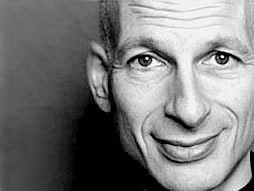Dr. Eliezer Jones is a friend of one of my colleagues on the Jim Joseph Foundation Fellowship at the Lookstein Institute at Bar Ilan university. He has been blogging daily about the Israel trip we just completed this morning. I want to share his posting about our dinner this past Monday because I think the experience and his posting raise the issue of experiential learning. We all do it. Do we do it well? Could we do it better? What are we missing? You can see the rest of his posts on Eliezer Jones's blog. The restaurant/theater is called Na Laga'at which means please touch, because people who are deaf and blind (as their actors are) need to use touch to communicate.)
Another amazing day on the JJF Fellowship Israel retreat. In fact, I feel a bit guilty that I have not been blogging about every aspect of the different days as there have been so many memorable experiences. For example, today we began with a presentation from Rabbi Seth Farber, Ph.D. Rabbi Farber is the founder and director of ITIM, The Jewish Life Information Center which is “dedicated to making Jewish life accessible to all” by fighting for social justice. Then we spent three hours learning together at ALMA Home for Hebrew Culture. ALMA “seeks to acquaint Israelis with the wealth of Jewish heritage” and is a secular Beit Medresh. However, although they are experiences I will never forget, it was how we spent dinner that changed forever the way I view an aspect of the human experience. We had dinner at The "Nalaga’at" Center.
According to their site, “The "Nalaga’at" Center, located at the Jaffa port in Tel Aviv, was founded by the "Nalaga’at" non-profit organization and opened its gates to the public in December 2007. The Center is comprised of the "Nalaga’at" Theater, home to the Deaf-blind Acting Ensemble; Café Kapish, with its deaf waiters and BlackOut, the pitch-black restaurant with its staff of blind waiters. The "Nalaga’at" Center currently employs some 70 people, most of whom are deaf, blind or deaf-blind.”
The JJF Fellows ate at BlackOut, the pitch-black restaurant served by blind waiters. To describe the level of darkness that exists there is to only to describe it as imagine you were blind, which for most of us is impossible to describe. I have never experienced such darkness. There was no adjusting to the darkness, being able to see edges or small rays of light. It was pitch black and my body was reacting in a way I did not prepare for.
As soon as we were escorted to our table conga line style and, yes, we did make choo choo sounds, I began to get anxious. This is not something I generally get. I was fidgety and talking more than I generally do, which is a lot. I began to notice perfumes, cigarette smoke (there is no smoking in the restaurant) and the aromas of the food as my other senses began searching to connect to something. I began to hear noises that overwhelmed my ability to hear the person across the table from me. My senses were frantic.
When are food came, things calmed down a bit. I ate delicious fish with my hands (although I had a fork and knife I kept bringing an empty fork to my mouth) that was warm but not hot lest I burn myself. There was no coffee or soup for that same reason. We had to pass each other water by touching each others hands. Someone spilled, but neither of us knew who it was. We shared bread. My friend kept putting half eaten bread back in the basket. Not cool. The waitresses had bells around their wrists so that we heard them coming and that they would not bump into each other.
This dinner, in such an intense manner, allowed me to “see” through the eyes of another that I would have never experienced unless I too, G-d forbid, were blind. It was only an hour and a half in the darkness, but I not sure I will see things the same way again. I am grateful for the experience and it enhanced my already strong support for experiential learning. I would recommend any school trip to Israel to incorporate The Nalaga’at Center. For those who do not make it here, there are many ways to learn about differences in others in the classroom through temporary experience (i.e. use a wheel chair in school for a day) that can make a significant impact on the perspectives of the students. Technology can also be of great assistance. Click here for a post about using virtual reality used to assist users in experiencing the positive symptoms of schizophrenia.








